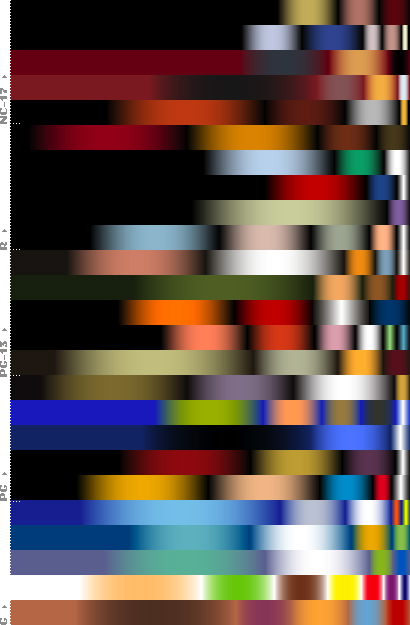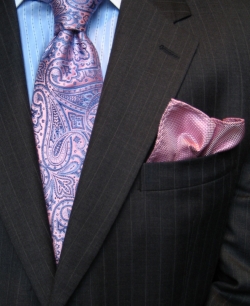Over this summer, I have had some interesting discussions and made some observations about white shoes. There are all sorts of strong opinions regarding these (not necessarily) flashy pieces of footwear. I have heard everything from "NEVER, unless they're tennis shoes" to, "Sure, why not?" with every kind of caveat in between. I must say, I've heard similar things about white jackets, suits, and the like. It seems white is a divisive color...
 |
| My new shoes! |
So, as the owner of a white jacket (but damn, I need a new one), I thought I'd try out the white shoes concept. My outfits these days tend to follow two modes since it's summer and I haven't had the fortune of being invited to any ritzy galas or anything of that sort. I am either in jeans and a t-shirt (both monotone) and wearing a blazer of some kind as well as a leather belt and shoes for casual days, or I am in slacks, a collared shirt of some contrasting color, and a blazer here as well, usually with a pocket square (I have eschewed ties for my long, hot commute on public transportation and because it would send the wrong place at my work) with the same style shoes and belt for my work. I thought I would try the white shoes for both these occasions.
 |
| Different angle! |
So, in testing these things out personally, reading different opinions, and also observing pictures and firsthand other folks wearing them, I've drawn some conclusions about how to wear these crazy things. There are several different sartorial situations that must be considered when thinking about white shoes. The first is when wearing a traditional suit (whether a tuxedo or a regular business suit). The second is when dressing in todays hazy "dressy" clothes that are something other than a suit. Finally, these pieces must be considered for casual outfits such as with dark-wash jeans.

Suiting is, in some ways, the simplest situation to deal with when considering white shoes. For a white tuxedo, or even with a white jacket and black pants, the white patent leather shoe is perfectly acceptable, and even expected in some cases (though black is a fine choice as well). For a regular white suit (probably of linen or cotton for the summer), the white shoe is certainly an option. It provides the same seamless line, the same unbroken color scheme, and, if necessary, gives a heightening and slimming effect because of this. It makes things run together and gives a very clean, fresh summery look. A friend suggested to me, and I agree with his analysis, that a two-tone shoe could liven up this idea. Put something else (nothing too wild, probably a tan, black or something of the sort) on top of a white shoe in a classy way and pair your shirt and tie to it, and the white suit goes beautifully with the white shoes. It worked for Elvis. That being said, I can just see the question popping up, "But... I don't have a white suit, and if I did, I sure couldn't wear it very often. Can I wear my shoes with some of my other suits?" This is a good point, and the answer is yes, if you're very cautious. At any point if too much contrast arrives you will have a disaster. The shoes will be the only part of the outfit anyone sees. However, if you are careful to mitigate this factor, it might be possible. As a ground rule, blue, black, chocolate, charcoal, and similarity colored suits are not good candidates for white shoes. However, with a tan (light tan), or light grey suit (particularly with white pinstripes), you might be able to pull of the shoes. This is especially true if you make sure that your shirt and tie pull the shoes in as part of the outfit and don't let them stand alone to stick out. As for belts, only pair a white belt if you're going with all white.
 |
| They're not dress shoes, but they give you the idea... |
Now, onto "business casual," or whatever you call it. This is what I have had the most personal experience with regarding my own white shoes. The rules for wearing white shoes in this scenario aren't too much different from those of the suit, but there's one added caveat. Once again, for the pants (the piece that will be immediately next to the shoes), make sure that you're wearing something light, roughly in the shades mentioned above. For the top however, you have more options. Go with something that contrasts, but fits the style. It could be a blue blazer, for instance, for a nautical look. There are lots of options at this point. The alternative is to flip this around. If you're wearing almost all white on top, white shoes might work on the bottom even if your pants are darker. Remember however, the more contrast, the less clean the look.

Finally, the casual, with jeans option. This is certainly a possibility. There are a lot of people who will tell you it doesn't work. However, there are a few things to consider when receiving this advice. First, a lot of less classy folks where white tennis shoes with jeans all the time. Now granted, they're not exactly fashionable, but these folks do seem to get by without people staring at them. Second, women have been doing this for a while. Their shoes may not show quite as much of their color, and women's fashion rules are different, but fundamentally, the concept works. So, why can't a man wear his nice white leather shoes with his jeans? Indeed, he can, but there are a few guidelines that will help. First, tend toward darker washes (even a deep navy) when you're doing this. Generally with suits and so forth, I recommend going lighter because it's less shocking, however, with jeans, that rich feeling of a dark wash is necessary to pull off the suaveness of the look. Because of this however, not unlike the "business casual" situation above, you need to have something on your upper half that will compliment the white shoes. It might be a shirt of some kind, or a white blazer. It could even be a white belt. Be careful with any of these options however, because once again, the more contrast, the more broken up, the less clean the silhouette, reducing heightening and slimming effects.
























